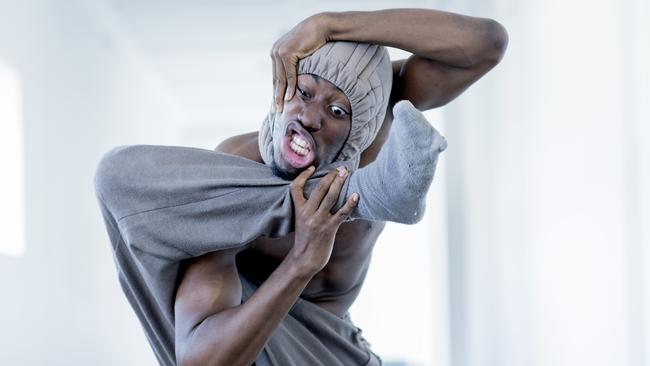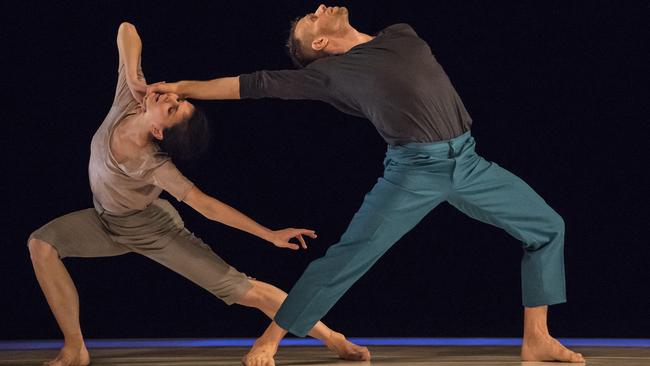The pandemic has played havoc with our heads, says BLKDOG creator Botis Seva
A lucid account of mental illness resonated with dancer and choreographer Botis Seva during a vulnerable time in his life.

When dancer and choreographer Botis Seva strolled into the National Theatre bookshop in London a few years ago, he was filling time before a meeting and musing on his next work. His experimental company Far From the Norm, which he had founded in a disused warehouse when he was 19, was winning plaudits for its message-driven mix of hip-hop forms, African dance and physical theatre. Hyped as the next big thing, Seva was feeling the pressure.
“I was frustrated at big venues telling me what work I should make,” says Seva, 30, from his home in south London. “I wanted to use this idea of an artist struggling with their truth in a piece about young people and mental health.”
Growing up in Dagenham in far east London, the son of a single mother, Seva had used music and dance as a language of expression, as a tool to combat childhood trauma and as a way of pushing back against the emotional fallout of social inequality and systematic racism. All too familiar with the “black dog” — a phrase often used to describe depression — Seva had picked up a display book titled Shoot the Damn Dog. For a long while he stood mesmerised, reading.
A lucid account of mental illness by successful magazine editor and journalist Sally Brampton (who took her own life in 2016), Shoot the Damn Dog resonated from the get-go: “I got halfway through it and thought, ‘Right, I am definitely making a show about all this,” he says. “I didn’t see her as a white middle-class woman. I just saw her as someone who was troubled, as many if not all of us are.”
So, then, to BLKDOG, a co-production between Far From the Norm and Sadler’s Wells Theatre that will live-stream as one-half of a double bill at the Adelaide Festival next week. Hailed by the Reviews Hub as “a searing hip-hop representation of vanishing youth”, BLKDOG burst on to the stage of Sadler’s Wells in 2018 as part of an evening of new commissions. It has since been developed, has won an Olivier Award (for best new dance production) and frequently has been misinterpreted.
The trailer for BLKDOG sets out its stall: six figures kitted out in androgynous grey outfits, variously slumped on the stage, moving rapidly on their haunches or visibly grappling with their private demons. A male dancer grimaces in close-up, wide-eyed and panic-struck, tapping his temples before cocking his fingers, gun-like, over a sharp elbow. “Everything is mixed into one pot of exhaustion, tiredness, grief and memories,” says a female cast-mate in voiceover.
Flashes of jerking, pulsing aggression are tempered with moments of tenderness and intimacy. Passages of freeze framing and fast-forwarding are heightened by Tom Visser’s lighting and Torben Lars Silvest’s futuristic score; silence, when it comes, feels electric. Sava’s recorded voice is in the mix, whispering here, murmuring there. “It’s OK,” he says. “He’s OK. She’s OK. You’re OK.”
Seva grew up listening to hip-hop heroes such as J Dilla and Busta Rhymes and had Kano and other pioneers of UK grime — the garage-influenced electronic dance music genre that emerged in London in the early 2000s — on repeat. He still makes his own loops and beats. “At the start all I wanted to do was make music, honestly. Grime still inspires what I do now, this music that came from nothing and became something. So all these influences are mixed into Torben’s score in a way that you know they’re there, but nothing is obvious.”
BLKDOG’s meaning is similarly nuanced. To infer that the work is solely a portrayal of black youth and gang violence, or to liken Seva to Jean-Michel Basquiat (a trope applied to many rising-star black artists without formal training) is to overlook the multiplicity of black voices — as well as the work’s more universal themes. There’s the battle between inner child and adult self, and the predicament of young people today. Crucially, there’s the fact that depression doesn’t discriminate, as Brampton’s book makes clear.
“Reviews of BLKDOG always talk about black gangs and refer to the dancers’ hoods, which are actually padded caps,” says Seva, who began going to dance classes after Avant Garde Dance, a company run by Tony Adigun, an early mentor, did a workshop at his school. “Of course there are racial issues. But it doesn’t shout race.
“Our intention is to take the audience on a journey and help alleviate some pressure in their lives. Help them feel less alone.” Especially now: “Being stuck inside during a pandemic has played havoc with people’s heads. If we can make even one person feel better by showing them there’s hope then we’ve succeeded.”
Seva was teaching his own sessions in Dagenham — his way of alleviating the adverse effects of funding cuts to youth projects — when he started participating in Breakin’ Convention, the hip-hop dance festival held annually by Sadler’s Wells since 2004. Soon he was popping, locking and gliding his way into residencies, mentorships and, in 2016, a month-long scholarship with Garry Stewart’s Australian Dance Theatre in Adelaide.
“I learned a lot just by observing Garry communicate with his dancers. He let me watch a lot of archive material including a bunch of [the ADT’s] short films, which was also inspiring,” says Seva, for whom cinema (particularly psychological thrillers) and mind-bending TV shows such as Black Mirror are big influences.
Short films are a vital part of his oeuvre. A three-minute 2015 YouTube video shot on the streets of east London showcases the idiosyncratic dance style he calls “experimental, abstract, crazy, weird, me”.
Seva explored his feelings of vulnerability around new fatherhood (he has a five-year-old son) in 2018’s Reach; last year’s Can’t Kill Us All (a collaboration with filmmaker Ben Williams) is a lockdown-filmed piece of dance theatre detailing the mental unrest of one man as he deals with two pandemics, COVID and the trauma of racism.

Can’t Kill Us All ends with an emotional voiceover from Seva’s UK-based, Congo-born mother. “My son, I know the world is crazy at the moment, especially for young black men,” she states, as Seva’s young son is seen running joyously about a park in pink shorts and sky-blue Crocs. “Never be ashamed of your skin colour. I pray for God to protect and guide you.”
“That’s my favourite bit of the film,” says Seva, smiling, whose work in 2019 as guest artistic director of National Youth Dance Company provided further insight on the experiences of young people.
A Sadler’s Wells project featuring 38 dancers aged 16 to 24 from across Britain, NYDT was set up to offer bright young talent the opportunity to work in a professional dance company and collaborate with a name choreographer; previous artistic directors have included Akram Khan and Sharon Eyal. Together with Seva, who interviewed each young dancer individually, they conceived and choreographed a dystopian work called Madhead.
“It is a piece that gets into the heads of young people and their thoughts about what the future could look like if society keeps going the way it is. I’m grateful that we got to do this,” Seva says. “Like I am for the chance to show BLKDOG again. I feel like I’m speaking on behalf of young people who are angry and want their frustrations and passions to be witnessed. They want to aspire. They want to change perceptions.”
The original 38-minute version of BLKDOG will follow Six Years Later, a 25-minute duet choreographed by Roy Assaf and starring contemporary dancer Jason Kittelberger and superstar ballerina Natalia Osipova, as part of the Live in Europe series streaming at the Adelaide Festival on March 6.

To join the conversation, please log in. Don't have an account? Register
Join the conversation, you are commenting as Logout